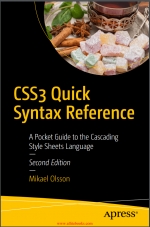CSS3 Quick Syntax Reference. 2-ed. M. Olsson

Категория: CSS
Поделиться:
CSS, which stands for Cascading Style Sheets, is a stylistic language that defines how web pages are presented. It complements HTML, which is the language used for describing the structure of web site content. Because HTML predates CSS, it includes a number of limited stylistic elements and attributes, but they have largely been deprecated in favor of the much greater design control offered by CSS. One of the main features of CSS is that it enables the complete separation of a web site’s presentation from its content. This separation reduces the complexity and repetition associated with including stylistic information in the structural content. Furthermore, this separation makes it easy to enforce site-wide consistency in the presentation of a web site because the entire look and feel of a site can be controlled from a single style sheet document. As one of the core languages of the Web, CSS is used today by almost all web sites to enhance the web experience. It has been a revolution in the World Wide Web and is a must-learn language for anyone working with web design. Like HTML, the CSS language is easy to learn and use, as is shown in this book.
Скачать
Комментарии